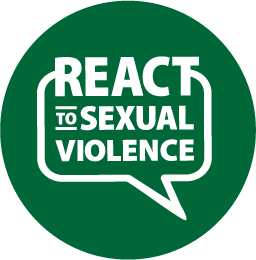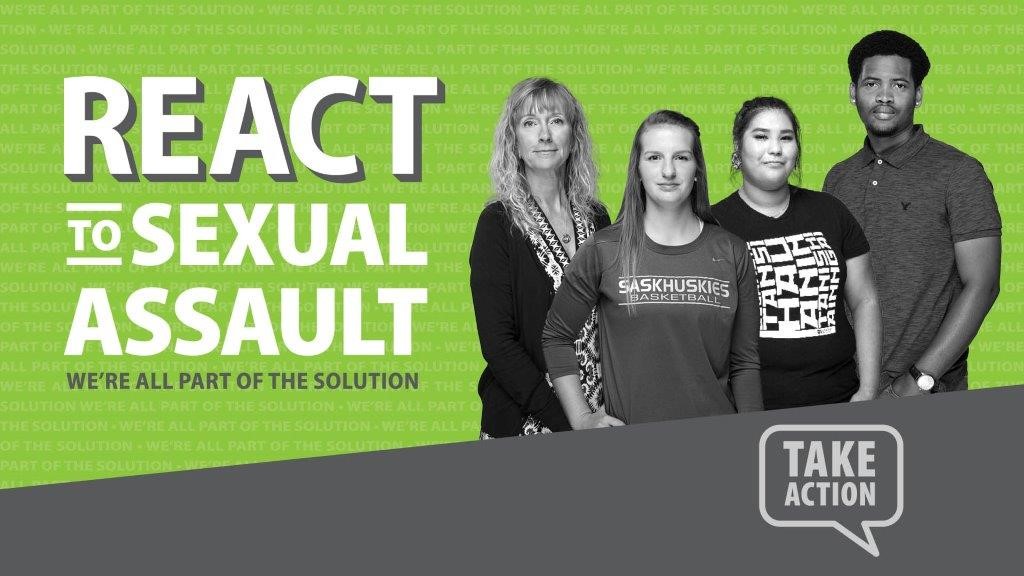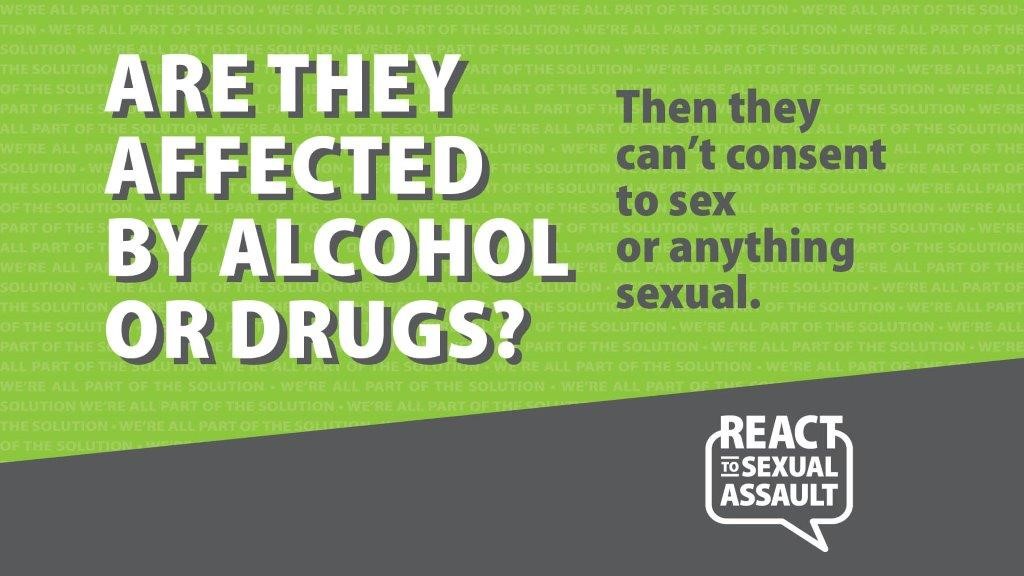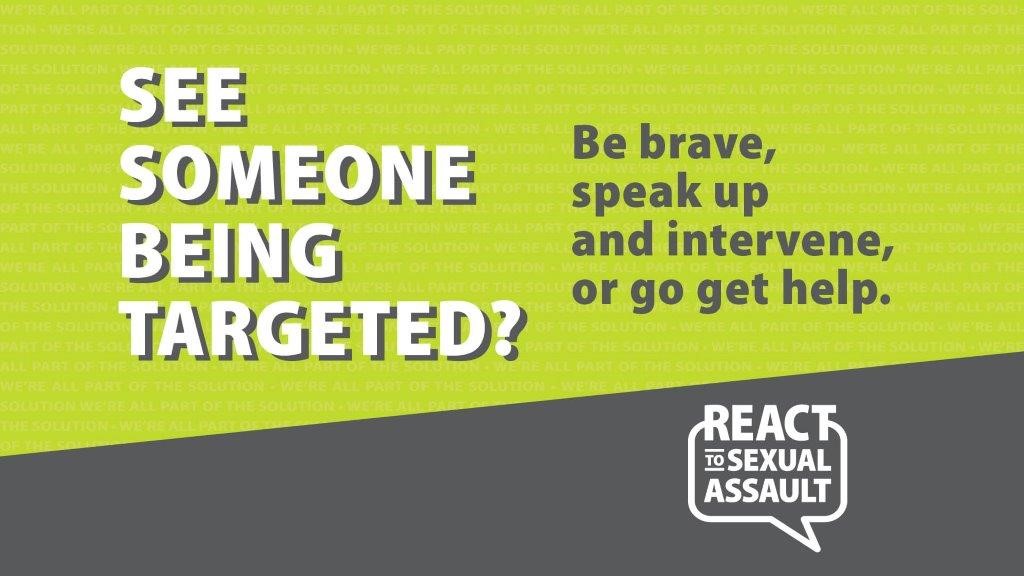
React to Sexual Assault
Sexual assault involves any sexual contact without consent. It includes kissing, fondling, touching sexual body parts, and anything up to forced sexual intercourse/rape.
By Student Wellness CentreWhat is Sexual Violence or Sexual Assault?
Sexual violence includes a spectrum of behavior that includes sexist comments and catcalls as well as rape. It’s important to recognize that these behaviors create an environment where rape and physical assault can occur.
Sexual assault involves any sexual contact without consent. It includes kissing, fondling, touching sexual body parts, and anything up to forced sexual intercourse.
Most sexual assaults are committed by people the survivor knows: friends, dates, partners (including spouse), parents, service providers, employers, and attendants.
Facts about Sexual Violence

- Sexual assault is not limited to male on female violence. Anyone can assault or be assaulted, regardless of gender.
- Most people tell the truth about rape. False reports are made at a rate of 2-8%, comparable to other violent crimes.
- Most (73%) of sexual assaults are perpetrated by someone already known to the victim as a friend, family member, or authority figure.
- In 2019, over 13% of USask students reported that they were sexually touched without consent; over 6% experienced attempted penetration or penetration without consent.
Facts about 2SLGBTQ Students
- 2SLGBTQ students report higher rates of sexual assault and harassment than heterosexual students.
- 2SLGBTQ students are more likely to receive negative peer support than their heterosexual counterparts.
What is Consent?

To give consent means to agree to participate in sexual activity. Although legal definitions vary, consent is:
- Enthusiastic
- Freely given
- Informed
Consent is NOT given when someone is:
- Silent or simply the absence of “no”
- Incapacitated by alcohol or drugs
- Responding to an abuse of power or authority
- Threatened, coerced, tricked, or bribed
If You Have Been Sexually Assaulted
- Go to a safe place
- Seek the help from someone you trust
- Consider seeking help from professionals, such as counselors or nurses at Student Wellness
- Get medical help, as you may have physical injuries or sexually transmitted infections (STIs)
- Preserve all the evidence of the assault. If you want to complete a rape kit for judicial or other reasons, refrain from washing yourself and go to a hospital as quickly as possible.
- If you can, write down all the information you can remember about the assault, including details about the location, attacker, and time.
How to Support a Sexual Assault Survivor
It can be hard to know how to respond when someone confides in you.
- Go to a safe place
- Seek the help from someone you trust
- Consider seeking help from professionals, such as counselors or nurses at Student Wellness
- Get medical help, as you may have physical injuries or sexually transmitted infections (STIs)
- Preserve all the evidence of the assault. If you want to complete a rape kit for judicial or other reasons, refrain from washing yourself and go to a hospital as quickly as possible.
- If you can, write down all the information you can remember about the assault, including details about the location, attacker, and time.
Utilize Resources
- If you have been sexually assaulted, tell someone: contact Student Affairs and Outreach for a resource package at (306) 966-5757 or visit 3rd floor Place Riel.
- Call Safewalk if you feel unsafe walking alone on campus: (306) 966-7233
- To request Bystander Intervention Training for your office or student group, contact student.outreach@usask.ca
How to Prevent Sexual Assault
You Can Make a Difference
- Always ask for consent in your personal sexual encounters. Care for your partners and communicate openly
- Believe survivors
- If you see something, say something: you have the potential to make a big impact on someone’s life.
- Intervene in conversations that promote an unhealthy perspective on sexual violence: call your friends out when they victim blame or dehumanize their sexual partners.
Speak Up; Speak Out; Speak Loud

When you see something; do something! When you hear something; say something!
When you get that gut feeling like something is wrong, you are almost always right. Doing something and/or saying something doesn’t always mean going fisticuffs with someone. There are many strategies you can use.
- Always make sure that you are safe. Never intervene if you feel like your life or safety is at risk. In these situations it is best to find safety then call the police
- Don’t be afraid to call the police if you feel unsafe. Situations where children are involved, weapons are present, or there is a high chance of physical harm, need to have police involvement
- Distract the perpetrator. If you feel comfortable, distract the perpetrator by asking for the time or starting another benign conversation
- Give the target an out. By asking the target if they want a drink, want to go home, go to the washroom, or have study tips for a class, you can give them the opportunity to leave the situation
- Get an authority figure. If you cannot intervene yourself but want to do something, find a bouncer, manager, instructor, administrator, or coach to intervene on your behalf
Speak out.
Sexual assault continues because we allow these actions to occur, sexist jokes to be funny, and survivors to be forced into silence. You can make a huge change just by refusing to accept aspects of rape culture such as violent films/shows, rape jokes, objectification of people’s bodies, and the support of celebrities who have committed acts of sexual violence.
Resources On and Off Campus
Student Affairs and Outreach
306 966-5757
student.outreach@usask.ca
Beyond SAO, there is a large community on and off-campus that can provide support:
- Friends or family
- Protective Services
- 306-966-5555
- Student Wellness Centre
- 306-966-5768
- Gordon Oakes Red Bear Student Centre
- 306 966.5790
- International Student and Study Abroad Centre
- Room 80, Lower Place Riel
- USSU Help Centre
- 105 Memorial Union Building
- USSU Pride Centre
- 104 Memorial Union Building
- USSU Women's Centre
- 103 Memorial Union Building
- Saskatoon Sexual Assault and Information Centre
- 306-244-2224 (24 Hour Crisis Line)
- Saskatoon Police Service
- 306-975-8300 (non-emergency line)
Download the USafe App
USAFE is the university's safety app, which features emergency contacts, safety tips, a personal safety tools, maps, and much more.

